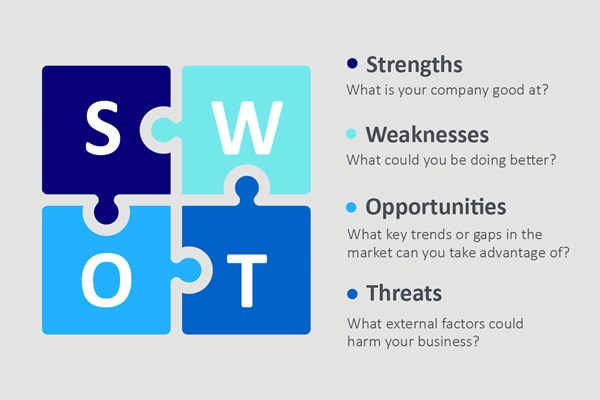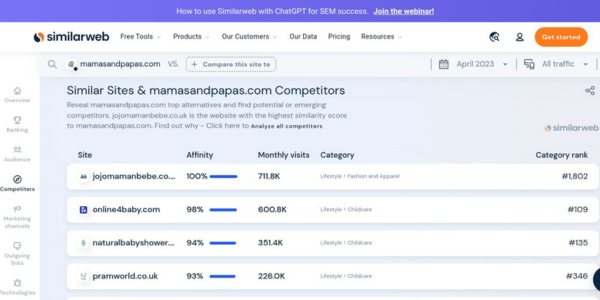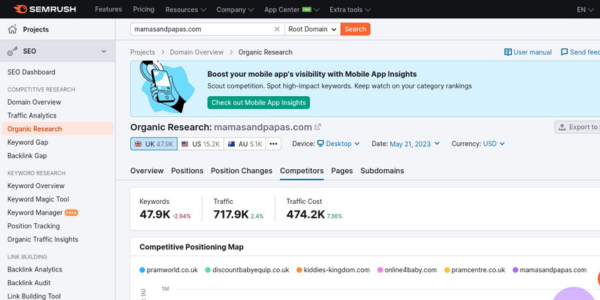Do you know who your online competitors are? Here's how to find out

- 23 June 2023
In a competitive landscape, it’s vital to stay updated with where your business is doing well, what it could be doing better and similar products and services available to your target audience. Not only does this help you put your best foot forward but opens you up to opportunities and make informed decisions. In this guide, marketing expert and CIM course director, Laura Bracher, shares her top tips to help you utilise this powerful tool.
When was the last time you conducted a competitor analysis for your business? If you can't remember, or it consisted of a quick browser search or social media sweep, this article is for you.
Have you considered a CIM membership? When you become a member you'll receive great benefits including access to our Marketing Expert guide where you can find more information. You can read our Competitor Strategies topic guide on Marketing Expert now.
What is a competitive analysis?
The purpose of a competitor analysis is to research other businesses offering the same or similar products or services to your target audience. It's an opportunity to learn more about their strengths, weaknesses, products and marketing strategies which, in turn, can help you make informed decisions about your own business.
A competitive analysis isn't just for new businesses, and given the fast-paced nature of marketing, it's worth conducting them periodically to ensure you remain on top of the current trends and maintain that all-important competitive edge.
How you analyse your competitors depends on your own business and unique goals. You can carry out a complete, in-depth competitor analysis (there are plenty of free templates online to help with this), or you can do a deep dive into one specific aspect. This article will focus on identifying your top online organic competitors, which are the companies you're competing against for position on keywords.
Why should you identify your online competition?
According to the latest Crayon State of Competitive Intelligence Report, since 2021, there has been a 55% increase in the share of stakeholders who say competitive intelligence (CI) is "absolutely critical" to their success (competitor analysis is a key aspect that falls underneath the comprehensive practice of competitor intelligence), and 99% of stakeholders say CI is at least "somewhat important" to their success.
With this growing number of companies using CI, it's clear that monitoring the competition is critical to scaling businesses and remaining competitive in an increasingly crowded market, but how does it do this? Here are some benefits:
- Identify strengths and weaknesses - By looking into how your competitors are perceived, you can learn a lot about your own strengths and weaknesses. Identifying strengths can help you influence your positioning in the market or how your target audience perceives your product or service. Highlighting why your product or service is superior (your Unique Selling Proposition) is fundamental for gaining customers. Likewise, knowing your weaknesses can help you understand which areas need improvement. For example, if a competitor has a superior checkout experience, then you might attempt to improve that element within your own businesses.
- Discover new business competition - While you may think you have your competitors sussed, strong digital investment from a new or previously unheard-of business can solidify their online presence and catch you off guard, which is why periodic analysis is essential. CIM course director, Sarah Jones, suggests that using platforms, such as TikTok and Instagram, offers an opportunity for your competitors to quickly reach new audiences and build large followings.
- Spot new trends - Analysing the competition allows you to see where your industry is moving, and you can use this information to stay up-to-date in your offering and even find gaps for you to turn into new marketing opportunities. However, if you see your competition is doing something you aren't, don't be tempted to do the same without proper research. Just because something is working for one business, it isn’t guaranteed to be the same for yours.
- Provide benchmarks - Analysing competitors can provide you with a valuable reference point you can aspire to. Equally, looking at new players in the market can give an idea of who might threaten you in future.

How to find your online competitors
Identify target keywords
Keywords are important because they help your target audiences to find you online. More recently, audiences are using social media platforms such as Instagram as a search engine and an alternative to Google or Bing. Ensuring you have strong SEO and keyword rankings across platforms is vital as part of your search strategy.
When identifying which keywords are important for your rankings, regardless of your industry, the first place to start is to identify your competitors and the keywords they are using. You won't be able to find your online competitors without knowing your target keywords.
These keywords are what you want to rank highly for in search engines, and there are a few ways to find them.
Start by making a shortlist of keywords that come to mind. These will probably consist of the products and services your business offers. You can also look at who you already know to be your competitors and see which keywords they use on their most important pages.
Once you have those, you can use free and/or paid tools to expand your list. Google Keyword Planner, Moz Keyword Explorer and SEMrush are good places to start.
Check Google
Once you have your list of top keywords, it's time to search for them on Google. Companies that appear on page one will be your biggest competition but pay attention to those on page two too. CIM course director, Sarah Jones, advises, "Decide where you want to rank for each of your keywords, typically aim for the top three positions on page one and the explore page on platforms such as Instagram."
Performing this kind of search will provide an idea of who your biggest competitors are and how much work you need to do to improve your rankings. However, don't get complacent if you do appear high up in the rankings. Google updates its search algorithms regularly, so even if you're performing well now, that doesn't mean a competitor can't take over at any minute.
You should perform this search for keywords relating to each of your core products and services, not just your main ones. This is because your competitors for each service or product might be different. For example, a graphic designer might look at "freelance graphic design services" and get an overview of their organic competition, but they would also want to know who is ranking for each of their core services such as "logo design", "typography", and "illustration".
Look for related sites
You can use Google again for this by searching using the operator "related:" followed by your website domain (here’s the full list of search operators if you’re interested). This helps you to find websites that Google sees as similar to your own and, therefore, a potential competitor. Note: you must use a lowercase' r', otherwise it won't work.
For example, use this command for domains related to "mamasandpapas.com" (this is what you would input: “related:mamasandpapas.com”), to see who their competitors are according to Google. Try a variety of large and small businesses to familiarise yourself with the tool. However, it may work better for larger websites.
SimilarWeb is another valuable tool for this, except you can also enter a competitor site to find more accurate results. However, you only get a limited number of results with the free version, but it's worth having as a comparison.

Perform a local search
Using Google Search again, type in your products or services followed by your location, which will bring up a list and map. For example, if you run a bakery in Clifton, Bristol, you can search for "Bakery Clifton Bristol". If you're a local business that doesn't sell online, these competitors are likely your biggest threat. Including your location within your keyword strategy will be an important step in being competitive for example, your company name or product/service plus your location).
Use review sites
You can check out your competition's reviews on Google and, depending on your industry, sites like Trustpilot and Yelp. Not only will you be able to see who's 'top ranked' in your industry (determined by customers), but these can also be a good source of information on what your competitor's customers like (and dislike!) about them. It also provides you with an opportunity to differentiate from your competitors. For example, perhaps you can focus on quicker delivery or a wider range of products if this is something your competitors struggle with and your audience demands.
Use paid tools
Not everyone has enough budget for paid tools, but if you do, they can be a great source of information for quickly and efficiently assessing the competition. In turn, you get more time to spend actually marketing.
SEMrush's Organic Research tool has a "Competitors" report that overviews your top competitors. It's based on the number of keywords a competitor ranks for and the number of keywords you and that competitor share. But this is just the tip of the iceberg, as there are many other available features. For example, it provides estimated website traffic, lets you differentiate spikes from trends, and understand the visitor experience on those websites.

Similarly, Ahrefs is another tool that allows you to look directly at organic competitor rankings. It provides information on keywords, search traffic, backlinks, top-performing content and more. Unfortunately, Ahrefs no longer offers a free trial, but SEMrush does, which is worth taking advantage of if you want to test before committing.
Of course, there are plenty of other available analysis tools, each with unique features and dashboards, so it's worth researching to find which suits your business better.
Final thoughts
Competitor analysis is essential for businesses that want to grow. However, there's no need to overanalyse. By employing some of the tactics and/or tools listed in this article, you've got a good chance of outshining the competition.
Use multiple data sets from different sources to join the dots and paint a comprehensive picture for the best results. And remember collecting these results is just one part of the puzzle. It’s also key to implement those findings into your future strategy if you want all that hard work to pay off.
Learn the approach that can help differentiate yourself from the competition and protect long term business with our Developing Your Key Accounts training course.

- 0 views

 FAQs
FAQs
 Log in
Log in
 MyCIM
MyCIM






